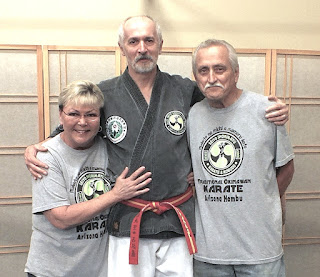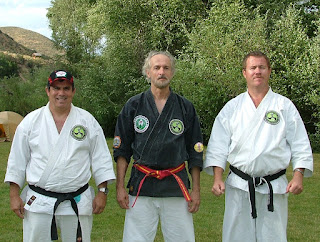Previously, Soke, taught martial arts at ASU, UNM, U of U, University of Wyoming, Gold's Gym, and the Hombu Dojo. After training and teaching for more than 5 decades, he helps students get fit, while focusing on safety, and enhancing self-defense capabilities. Soke, a father, grandfather, and even a great-grandfather, has a blood pressure of 120/78 with blood oxygen at 99. In fact, we tested soke's vital signs this morning (4/22/2022) and they were 122/76, heart rate 71, and blood oxygen 98. Keep in mind, he is of the same generation as President Trump. But how does he do it?
Prior to the pandemic, he trained at Mountainside Fitness 3 to 4 times a week, trained in karate 4 to 6 times a week, taught self-defense classes clinics to church and Christian groups.
He also has duties as a scientist (geologist and astronomer), writer, and public speaker. In addition to good physical health, he is a devoted Christian and attends bible classes each week and hopes to attend post-graduate studies on the Shroud of Turin - a burial cloth of Christ that is the most researched artifact in history. So-far, the cloth can only be explained as a miracle, in which 2D, 3D and X-ray images were produced along with video, and holographic images caused by a very short-burst of extremely intense radiation on linen cloth that is normally, non-sensitive to any photographic techniques. Scientists have been studying this linen for several decades now, and still cannot duplicate the technique - it is far beyond current technology.
But, back to fitness. Soke likely gets a lot of his energy by his polymath characteristics. He is always active and always has been. He eats once a day and sticks to the Okinawa adage of 'hara hachi bu' (eat until 80% full).
 |
| Two outstanding seniors in Seiyo Shorin-Ryu. Sensei Paula Borea with O'sensei Bill Borea (RIP) receive hugs at the Hombu in Mesa, Arizona. |
We now have three black belt senior citizens who had knee replacements who train with us. One, Japanese-American woman, had both knees replaced due to lack of control by her former Taekwondo instructor. Another, a cowboy from Casper, Wyoming (now in Arizona), had one knee replaced due to a tumble over a Mesa sidewalk; and the third person, our friendly ER user from Mesa, wore out his original knees because of the many incidents in the past, such as falling off his roof twice.
 |
| Congratulations Jeff! Senior citizen and military veteran from Mesa, receives certification for 1st degree black belt in Shorin-Ryu karate and kobudo. Presented by Soke Hausel in November, 2021. |
So, you may get the impression the members of this hombu dojo are all seniors who can barely get out of bed. Not so, all purportedly jump out of bed and keep in relatively good shape through karate and kobudo training a few nights each week. But, for those who have children and grand-children, soke allows them to sign up their offspring at no extra charge, and train with their parent or grandparent. He believes that karate families stay together. And then, we also have some members who recently graduated from college.
Some of our more outstanding seniors include a sensei (3rd degree black belt) who passed away at the age of 72 a few years ago from cancer. Until that day, he was at the dojo as often as he could, but had physical problems acquired as a pilot in the Air Force. Some years ago, he had took a month off of training to have open-heart surgery. Typically, it would take months before such a person could return to karate; but sensei Borea was back in the dojo a month later. So, if anything, karate makes people more healthy and more tough than the average person!
 |
| Dr. Sigalov (shodan) at UW karate. At this point, Dr. Sigalov was in his late 70s, and believe it or not, he was by far the fastest karate ka in the UW group, and also had tremendous strength! |
Soke: now a senior citizen who trained in Okinawa and Japanese martial arts his entire life, trained under a few of the best martial arts instructors in the world, began martial arts in kyokushinkai karate (full contact). Today, he continues training in shorin-ryu karate as well as other arts. He keeps training in martial arts and did much of his past when he had a full-schedule of geological research at the Wyoming Geological Survey, University of Wyoming, as well as private consulting projects around the country. How can one person do so much? According to soke, he has been blessed by God.
 |
| University of Wyoming Shorin-Ryu Karate, 1999 |
 |
| Seiyo no Shorin-Ryu Karate Kobudo Kai hombu photo, 2019, just before the pandemic. |


